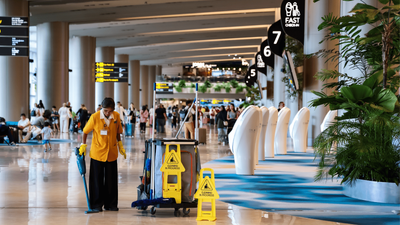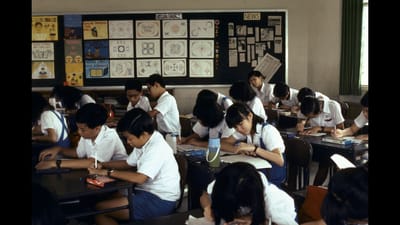Life is difficult for activists in Singapore. It has always been challenging in this highly controlled country governed by an extremely authoritarian and repressive system. Tharman Shanmugaratnam, a candidate in the upcoming presidential elections, has been part of that system. How can one reconcile Tharman’s participation within this repressive system with his early idealism and promises to be an independent unifier of our multicultural society if he is elected president? I am excited about his idea of the third space to enable Singaporeans to participate in each other’s culture. But this will require Tharman to make good on his promise to involve civil society.
What’s the problem? Political life in Singapore is mired in manipulation, opportunism and obfuscation. We need a president who can respond to the yearnings of its people for a just and fairer society. Unfortunately, many, who are otherwise admirers of this presidential candidate, are too angry with the ruling People’s Action Party (PAP) government. They are tired of being manipulated. Will Tharman pay the price?
I think the president’s office is the only avenue left that can help to foster a more inclusive, compassionate Singapore. The release of Kirsten Han’s The Singapore I Recognise perfectly coincides with this election. If the president is truly interested in the work this generation of activists are undertaking, he would do well to read Kirsten’s book. She narrates the remarkable and often bizarre experience of activists who have to negotiate a minefield of oppressive legislation on a daily basis. Forty years ago, my contemporaries and I treaded the civil society terrain cautiously worrying about the OB (out-of-bounds) markers that we might inadvertently cross. The Internal Security Act (ISA), which among other things, empowers the government to detain without trial those it deems a security risk, hung over our heads like a Sword of Damocles. Kirsten and her generation of activists know exactly what the terrain holds for them and they go ahead anyway.
How do you explain activists like Kirsten Han? They take risks, more risks than their predecessors were prepared to take. They have little memory of a history of activists who forged their activism through the rough and tumble of the early struggle for independence. These young people are well-educated and middle class. They function within a system controlled by people whose standard answer to challenges to their rule is to introduce more and more legislation in an attempt to crush the spirit of these young activists. But their passion for social justice is not easily extinguished. The contest is between the authoritarianism of the government and the liberal yearnings of this generation of young people. Whatever the restrictions and legislation imposed on them, these activists have shown a willingness to push the boundaries of acceptable behaviour.
Kirsten’s book is an honest reading of a Singapore and civil society that most people would rather not think about. I recommend the book for three reasons. First, her essays reference important historical events. Second, they provide evidence that will be of great interest to observers of civil society. Third, they shed a light on the humanity of the people who come under the punitive laws of the Singapore government.
Kirsten raises significant social and political issues, and shows us the way to make connections with the concerns and interests of those who are unable to speak for themselves. She offers a refreshingly candid account of the contemporary history of civil society, and the activists struggling to remedy the damage our public policies leave in their wake. The Singapore I Recognise is history, both public and personal, commentary and reflection based on her experience. Like a well-trained journalist, Kirsten writes clearly and succinctly. The ability to write well, to think clearly are very eloquent and essential contributions to her civil society community. It is so often said that the responsibility of any public intellectual and or activist is to speak truth to power, and she does that well with honesty and compassion.
Silence is not an option for Kirsten. This book is her response to people, prompted by the statement our ambassador to the US made that he “cannot recognise the country [Kirsten] describes.” And so she begins the memoir by quoting him. A brilliant start, Kirsten. She addresses people like him who, either through ignorance, apathy or arrogance, are blind to the part of Singapore that exists outside of their shining city of condominiums and black and white houses. Her assertion that these stories aren’t “alternative to anything” is established in the opening chapter of the book. “They just are,” she wrote. And “...they have as much right to be acknowledged as part of Singapore as any other.” It is a clarion call for the right to tell the story as she sees it. Kirsten’s account is special because she makes visible the marginalised, the poor, the forgotten and the suffering. Her humanising approach is valuable particularly in the campaign against the death penalty. She dedicates a significant portion of the book to her concerns about this law and the individuals caught up in the government’s dragnet. She calls on us to confront them as people; men and women who are somebody’s children, somebody’s brother or sister or husband or wife or mother or father.
Kirsten, like her generation of Singaporeans, grew up in an education system where students were ‘de-politicised’ by the time they left school. Her political awakening had come much later, when in 2010, she witnessed the family of a young man on death row in front of the Istana, on their knees, pleading to the authorities to spare the young man. She joined the campaign to save him from the gallows (he didn’t escape Singapore’s draconian laws against drug trafficking) and that experience, she said, “pushed me to look at my life and my country with new eyes.” It was the beginning of a long and dogged campaign against the death penalty. Kirsten founded the Transformative Justice Collective with her fellow activists.
We need to gain a clearer view of what has happened to us before, even if it was dark and painful, she wrote. One of those dark and painful memories that still constrains activism is fear. The origin of this fear is 1963’s Operation Coldstore and 1987’s Operation Spectrum. Every major institution—religious, legal, trade unions, media and other NGOs—that in other democracies might provide the checks and balances, present alternative views, protect rights were and are restricted, through legislative measures, from speaking or acting beyond limited, prescribed boundaries. History is important for us to understand how we see ourselves as people, as citizens and the possibilities for political participation.
Young people shake their heads in disbelief when I tell them that our government had arrested 22 people, labelling them “Marxist” on the charge of trying to overthrow the government, and that the ISA interned them without trial. We didn’t believe those charges then. We don’t now, either. Marxist conspirators at a time when Marxism was a dying ideology? The effect of the use of the ISA was to engender fear—fear of activism, fear of speaking out, fear of challenging the government. Now, even before you can strike the last key on your computer, you fear you might be “POFMA-ed” (Protection from Online Falsehoods and Manipulation Act), the latest law controlling citizens’ right to speak out. This is no way to live as citizens of a free, democratic country! We have normalised our way of activism—constrained by our fear, saying the right thing but worrying that it could be interpreted differently by the authorities, by talking in whispers, by treading carefully. But Kirsten maintains that unlike the response of older generations, hers is not paralysed by fear. To recollect is to limit our imagination of the avenues for action available to citizens she counters.
My own experience of activism and understanding of history informs me that nothing is gained by silence. Silence perpetuates the injustices, the abuse, the apathy. It empowers the perpetrator. But the gains achieved towards a more progressive society were the result of hard work and even louder advocacy work. Don’t let anybody tell you anything different.
Let me cite a few examples. The Women’s Charter, the legal recognition of domestic violence as unacceptable and the subsequent legal protection of victims of domestic violence, the promised repeal of the sodomy law S377A, and the consequential elections of 2011. That was when we witnessed a major vote shift away from the PAP which led them to make real changes, including salary cuts for senior politicians. For all its blandishments, which in themselves have led to a decline in its moral authority to dominate, the PAP is ultimately dependent on the support of Singaporeans for its dominant political position. In its struggle to maintain control, our government is trapped within its own system of control and power. What new ideas have they come up with to harness the energy and passion of this new generation of activists, or even to inspire the trust and loyalty of citizens?
Civil society has more positive stories to tell. The first example of successful advocacy comes from our early history when a group of women organised themselves to run a campaign against polygamy. Their catalyst was the sight of countless women and children abandoned and living in poverty. A confluence of factors led to their success. The campaign was mobilised and led by Shirin Fozdar. She was an amazing campaigner. She introduced activism to English-educated women, who then founded the Singapore Council of Women in 1952 with a membership of 3,000 women. This was the first politicised women’s campaign in our history. A parallel movement was led within the PAP by Chan Choy Siong who was a powerful advocate of women’s rights. The PAP was trying to establish hegemonic control of Singapore and was struggling against the Barisan Socialis. They needed women’s votes. As a result, women’s issues were particularly highlighted during the 1959 elections with a promise that “women will have rights and opportunities”. Fozdar was a brave and spirited campaigner, once threatening the politicians with God’s anger. She described Singapore as a brothel (a reference to the practice of polygamy). During the campaign, she began a letter with a reference to the turmoil in government caused by what she called “immature statesmanship”. But the politicians of that period were of a different mode, much more tolerant of opposing views and feisty women. Her spirited campaign was reflective of a period of open civil society and a democratic form of government. May 1961 witnessed the passing of the Women’s Charter bringing to a climax the fight for women’s rights that began in 1950. It outlawed polygamy, protected the rights of women in marriage, divorce and property ownership making the Charter one of the most progressive sets of laws at the time.
The second came with women’s resurgence into activism with the Association of Women for Action and Research (AWARE), who challenged the government’s patriarchal attitudes and values in its population policies. AWARE’s feminism offered a critique of society and a commitment to social change, which had not been attempted in the political culture of the PAP since the early activists campaigned against polygamy. Their advocacy challenged all, who were disturbed by the power of dominant ideologies to control, to engage in ongoing, critical self-examination about how we lived in our world. Through its activities and writings, AWARE set about subverting the way people thought about power and control by shifting the PAP-controlled ground towards a more open debate on women’s issues.
Kirsten is generous in her appreciation of AWARE’s history of advocacy. But for those of us who were activists then, those were difficult years. AWARE was a lone voice at a time when we feared the threat of the use of ISA. Some of those interned were members of AWARE although it was not implicated. That was almost 40 years ago. AWARE’s success as a leading civil society organisation, and its long history and comfortable position may inure the NGO to the struggles of newer activists trying to test the current boundaries of accepted behaviour. I hope not. I remember AWARE breaking the rules of acceptable behaviour of the time. My recollection of those early days was one of loneliness and fear. So it bothered me to read about an incident that Kirsten relates and AWARE’s response to it. It took place in January 2021 when the friends of a transgender student protested outside the Ministry of Education for interfering with her medical transition. Within the hour, they were arrested. Later that year, the police let them off with a conditional warning. These young protesters received support from other groups but AWARE came across “as more ambivalent”. Its statement concluded by asking the government to “act with leniency”. Naturally, many of the activists were dismayed and disappointed. I was horrified, as I read the statement. Had AWARE forgotten its early struggles and feminist values? There isn’t much sympathy for pragmatism, for compromise, and for those who pander to oppressors and play by the rules to win favours. “…the notion of breaking the law as a deliberate act of activism is no longer taboo,” Kirsten wrote.
The third, the current period, is the phase dominated by braver and even radical young people with demands for more freedoms of expression, social justice for the disenfranchised, the marginalised and the alienated in our society. If there is a context to this new direction in civil society it would be the “AWARE Saga” of 2009. The takeover of the country’s most well-known women’s rights groups by a group of conservative Christian women sparked a chain of events that not only enthralled the nation, but also forced many to re-examine the way they viewed civil society politics in Singapore. In the space of barely four weeks, 3,000 people from all walks of life became members to attend the extraordinary general meeting to wrest the organisation back from its interlopers. People remember that event, narrated in the “AWARE Saga” podcast, as the most spectacular exercise in democracy since independence. It shook many out of complacency and into activism.
Kirsten and her community of activists did not emerge from a historical vacuum, but as part of a strand of history that began at independence. The real background to the movements that gradually assume political significance don’t consist of overtly political events of confrontation between different forces or concepts that are openly political. Each generation takes a step, sometimes many steps towards a more progressive, compassionate society. As an activist myself, I appreciate the kind of courage of conviction that Kirsten has displayed, that suspends fears about the fallout to oneself. As her account shows, they are confronting problems facing minority rights (including LGBTQ issues) and freedom of expression establishing the fact that, in spite of the oppressive legislation that the government trots out to counter the perceived threats that these advocates pose, civil society will continue to grow in strength.
I am sure that Kirsten speaks for me and many other activists with her conclusion: “I feel strongly about this,” she wrote, “because it’s precisely these issues and histories, these imperfections and problems, these people and their efforts, that have enriched my experience of my country, changing my relationship with Singapore in ways that have shaped me to become more rooted, more committed, than I had even imagined I could be.”
It’s the way to go, Kirsten.
Kirsten Han’s The Singapore I Recognise: Essays on home, community and hope (2023) launches on September 1st, but can be preordered online here.
Constance Singam is a writer and civil society activist. Constance has led women’s organisations and co-founded civil society groups, as well as been a columnist in national publications. She co-edited several books, including: A History of the TWC: Building Social Space in Singapore (2002); Singapore Women Re-Presented (2004); and The Art of Advocacy in Singapore (2017). Her memoirs include: Where I Was: A Memoir From the Margins” (2013); Never Leave Home Without Your Chilli Sauce (2016); and the second edition of her first memoir, Where I Was: A Memoir About Forgetting and Remembering (2022). In 2021, Constance wrote and illustrated three children’s books. She was inducted into the Singapore Women’s Hall of Fame in 2015.
If you enjoy Jom’s work, do get a paid subscription today to support independent journalism in Singapore.
Letters in response to this piece can be sent to sudhir@jom.media. All will be considered for publication on our “Letters to the editor” page.







